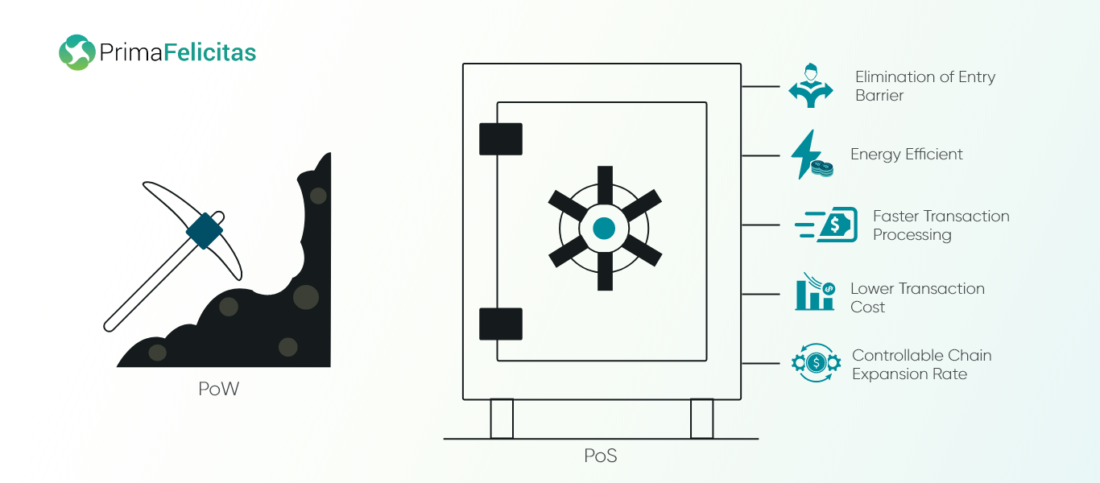
Blockchains rely on consensus mechanisms to maintain the security and integrity of transactions and to verify the state of the network. Proof of Stake (PoS) is one such mechanism. In PoS, transactions get validated by the accounts (validators) on the network holding the biggest stake in the network. The validators then receive incentives for participating in the validation process.
Growing adoption of digital assets within individual and institutional portfolios, demands scalability within the system while ensuring immutability and security, decentralization remaining uncompromised. Proof Of Work, the consensus mechanism most popular before PoS depends on raw computational power for minting, and due to limited currency, the costs are too high.
Despite unmatched security, PoW is a huge concern because of its adverse environmental footprint, exponentially rising with the computational power needed to mint the tokens to add more blocks to the chain. Along with that, PoW favors only those participants to become validators, who possess high-tech computing equipment to perform the complex calculation. As the chain grows PoW enforces increased complexity thus causing long delays in transaction processing, that keep growing further in sync with the growing length of the chain.
Wider participation opportunities, reduced energy requirements, and faster and cheaper transaction processing have led the path to developing more thoughtful consensus mechanisms. Maintaining decentralization and ensuring security persist to be directive forces.
The PoS Mechanism
- Mining Power: In PoS, the validator is picked by a semi-randomized algorithm, that gives weighted preference to those holding a bigger stake. The probability of being a validator is directly proportional to the currency held in the wallet. Not just that, improvised algorithms consider the duration of holding, the portion available for staking, and how long the wallet has been actively staking in consideration too.
- Validation Process: Staking is the process of locking one’s assets, in order to be able to validate transactions. Once selected, the validators agree to verify the transactions in order. They verify transactions and commit them to the block which is finally added to the chain.
- Compensation: On adding the block to the chain, all validators receive their incentives. the incentives result in increased wealth and thus better chances to be a validator in the future. These incentives are known as staking rewards.
The process is not as straightforward as it appears, at first glance, it implies that the wealthy will become wealthier and thus might result in centralization. Selection algorithms employ various mechanisms to randomize the election of a validator and put not just the currency but more at stake. These mechanisms are not a part of this blog, but maybe a later one would discuss them in detail.
Why PoS over PoW?
“The big positive effect is that consumers get to participate in the consensus mechanism. It’s more scalable and they can participate in the staking rewards. They will benefit greatly by being able to participate in a broader ecosystem,” as stated by Jahon Jamali, who is a leading expert on emerging technologies, global risk management, and international relations.
Elimination of Entry Barrier:
PoS does not need the validators to own high-end computational equipment to have an opportunity to take part in the consensus process. Thus all nodes on the network have equal opportunities.
Energy Efficient:
As the need for complex computation is reduced, the PoS consensus mechanism turns out to have a fractional environmental footprint. Thus proving to be better for the environment as well.
Faster Transaction Processing:
PoS is not dependent on some complex problem to be solved to have miners available to validate transactions to create new blocks.
Rather the chosen validators stake their holdings, verify and get rewards. This process is much faster.
Lower Transaction Cost:
As a validator need not deploy computational power to be able to provide validation, the costs to be a validator are drastically reduced. Every transaction can be verified with a simpler and more efficient mechanism. To top it up, the validators are incentivized generously to ensure they make decisions keeping the wellness of the network at the forefront.
Controllable Chain Expansion Rate:
PoS has the capability to pre-program the intervals when validators are elected to verify transactions and hence add blocks to the chain. Thus PoS offers more control over when a block can be added to the chain.
PoS Vulnerabilities
Any consensus mechanism serves as a tool to maintain the sanctity of the network, inherent to any tool are its shortcomings as well. PoS being a new mechanism, is bound to go through its share of grilling in the network and evolve into a robust mechanism.
Network Centralization:
PoS runs the risk of monopolization in the network. As the validators with more stake weight enjoy higher chances of earning more stakes, the network might eventually end up in the hands of someone with more than 51% stakes. Although this is not very likely to happen, still a possibility exists. Read more about why the probability is very low here:
https://viktorbunin.medium.com/proof-of-stakes-security-model-is-being-dramatically-misunderstood-4ed7b19ca419
Nothing at stake Problem:
PoS mechanism relieves the validator from employing any costs in terms of computing power (like in PoW) or currency (Like in PoB), thus making it much more convenient to put bad information or create illegitimate forks. It is easier for validators to mine on competing branches aimed at maximizing their transaction incentives.
Hacking and Theft:
PoS allows for a deeper impact on the network in case of hacking or theft of currency. Inbuilt capability to grow one’s stakes by participating in the validation process allows for ease of growing one’s earnings even though gained from illegitimate sources.
Slashing sabotage:
A coordinated attack through a compromised node can easily knock off a major part of the network thus rendering a large portion of stakes unusable and opening the network for double-spending or halting attacks as most end users do not possess a good grasp of needed security measures.
Stake Grinding:
As the staking process is dependent on the election of validator randomly, tampering with the election process is the most obvious way to get preference in the validation and hence increase one’s incentives by validating more blocks.
Risks associated with Staking:
Individuals participating in the staking process, risk their holdings by putting them at stake. In case of any network breach or a loss of the project, they may lose their holdings.
They need to remain available as per the predefined terms and conditions to participate in the validation process in order to avoid slashing.
Above all, the liquidity of the wallet is reduced. Staking involves locking the holdings for some time period or until some condition is reached, rendering the holdings unusable till then. Even withdrawing from the staking also involves following certain rules to ensure no losses are incurred.
PoS Evolution
Being the second most used mechanism, PoS is going through a lot of improvisations. Every individual agency is employing its own separate mechanisms to enhance the security and capabilities of consensus building. Also, ensuring decentralization and improvising user participation is one of the major goals.
DPoS: Delegated Proof Of Stake:
This mechanism adds a second layer of scrutiny where delegators elect the validators from among the highest stake owners, by voting. The chosen validators stake on their behalf. Thus stretching the accountability of verifying only legitimate transactions, across the second layer adding leading to a fair consensus-building process.
Staking Pools:
Some protocols are also employing the creation of staking pools. This is beneficial specifically for owners of smaller stakes, who can pool up to together own a bigger stake and enhance the decentralization of staking power.
Multi-layer staking:
Apart from only the size of stakes, the duration of holding the stake. Also, failure to remain available for a certain amount of time, for validating the transactions also results in Slashing. Which causes the user to lose his holdings equal to the amount that earned him the validator status on the network.
Improvisation on Staking:
A validator is selected by a pseudo-random algorithm, for a predefined time slot. The validator has the right to create a single block that must point to or be linked to a previous block. This eliminates the risk of parallel validation for multiple chains by the validator and blocks converge towards a single growing chain.
This allows the consensus to come from within one block and removes the dependency on the size of the chain. Validators are allowed to randomly propose blocks and the decision to conclude one of the blocks as canonical is made by a voting mechanism. The voting takes place among the validators themselves, to permanently agree on which block to include in the chain.
The Future Of Cryptocurrency Is Green
Energy consumption has been one of the biggest concerns with mining systems deploying hashing power to form consensus and increase the amount of crypto in circulation.

PoS has been instrumental in driving the currencies towards the goal of decentralization of consensus keeping environmental footprint at bay.
The whole crypto-world is going through socio-economic evolution with experiments to test and deploy blockchain in every possible field of currency exchange. PoS is bound to evolve to stay in the market as well. With the emphasis globally on carbon-neutral technologies and inherent support for the same within SoP is a vehicle to reach a perfectly decentralized consensus mechanism to securely manage the transactions.
Looking for help here?
Connect with Our Expert for
a detailed discussion
Post Views: 1

